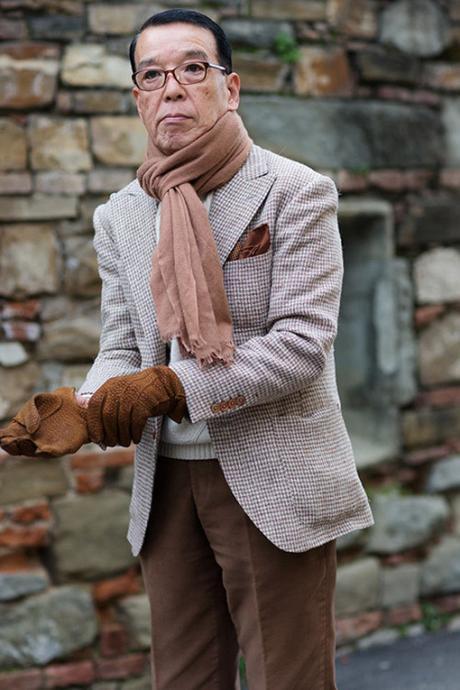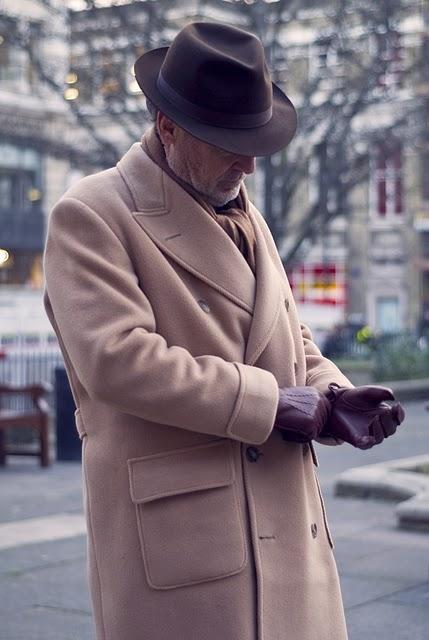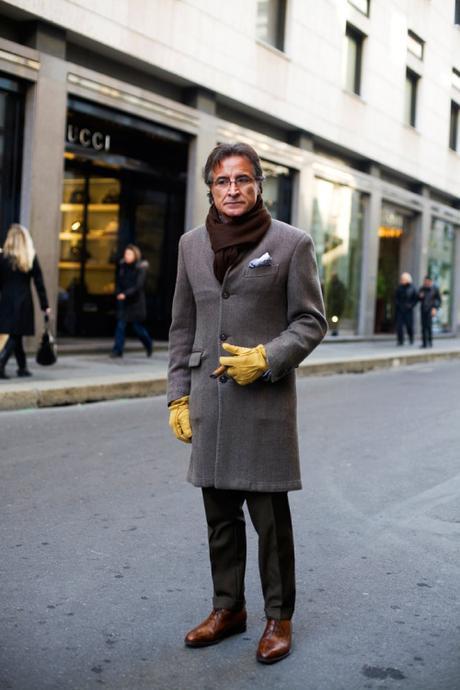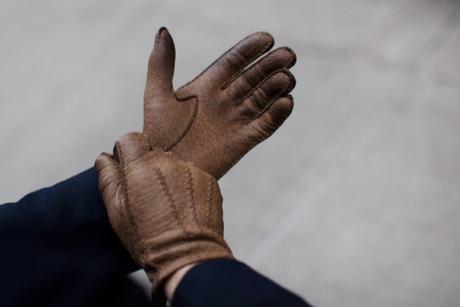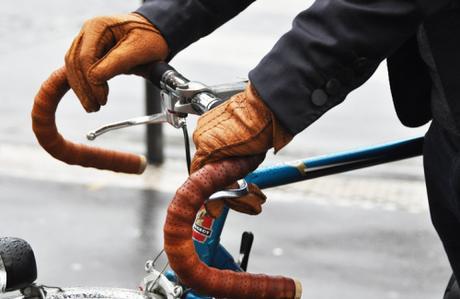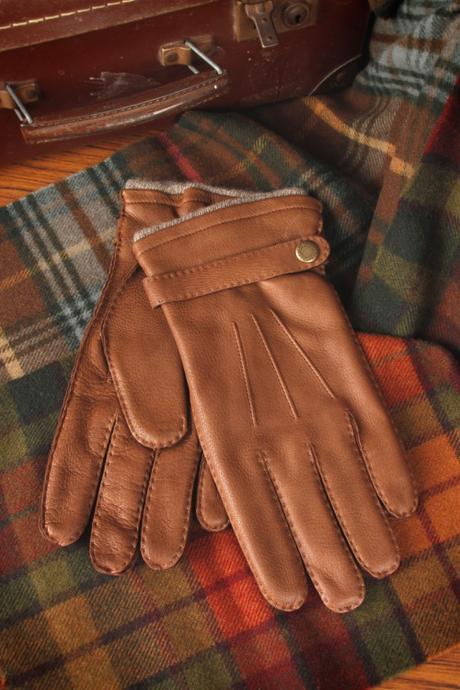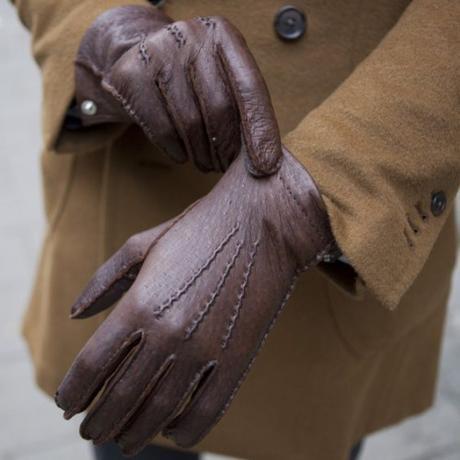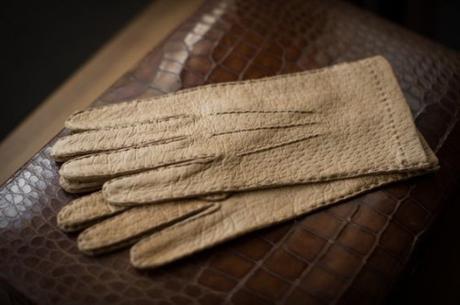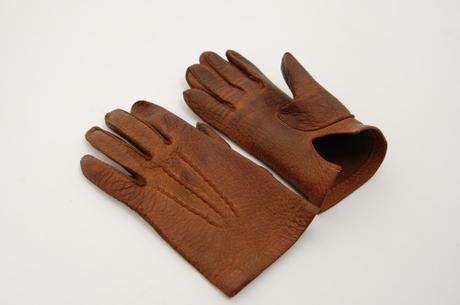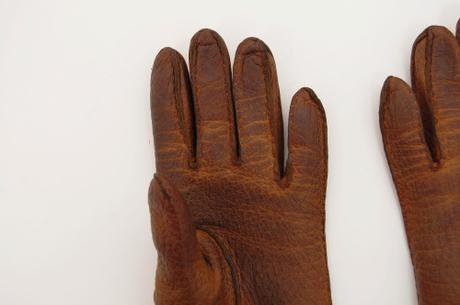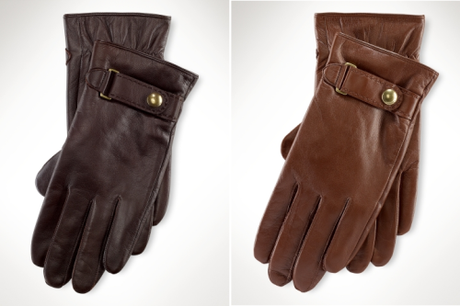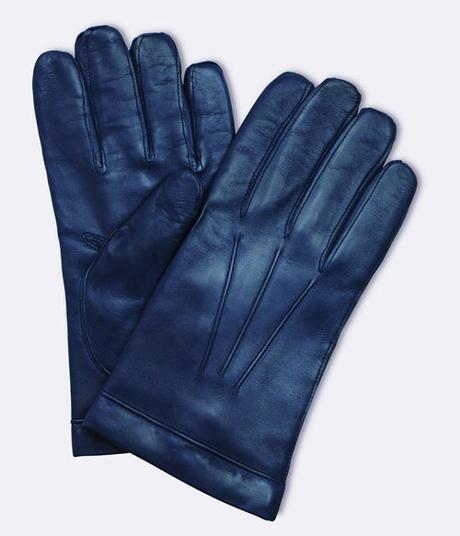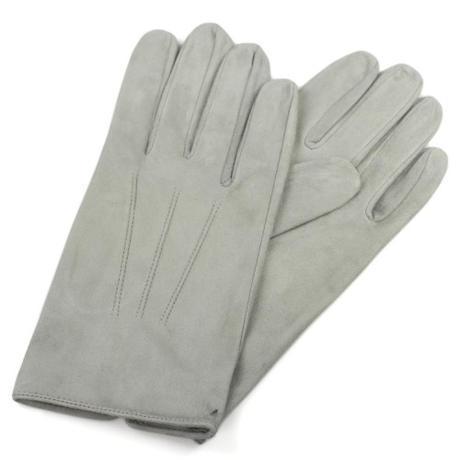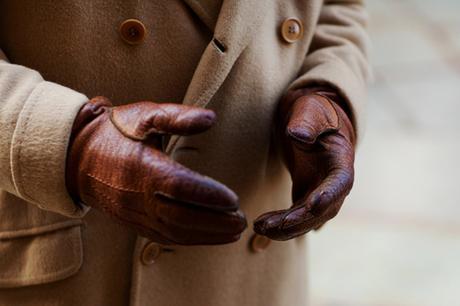
Gloves aren’t just a style statement this time of year; they’re a practical necessity if you live someplace cold. I’m in Canada at the moment, visiting family, and can’t even leave the house without a pair already on. Plus, check out Luciano Barbera’s beautifully aged gloves pictured above – old and richly patina’d from years of use. Such gracefully aged gloves can be a nice way to add interest to a winter ensemble.
If you can only own one pair, get them in dark brown. Something made from a soft and supple Nappa leather will be versatile enough to go with almost anything. You’ll also want to get them wool-lined, if not at least cashmere-lined. Unlined gloves fit closer to the hand, but you’ll appreciate the added warmth of wool-lined gloves when temperatures drop below forty.
If you have room for more than one pair, however, I think it’s nice to get some that go with certain outfits. Think about the material, stitching, lining, and even silhouette (yes, gloves have silhouettes). A rundown of what I find particularly useful for my wardrobe:
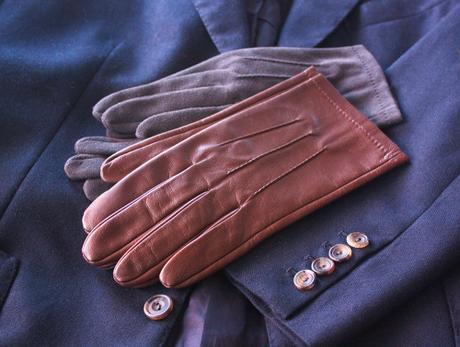
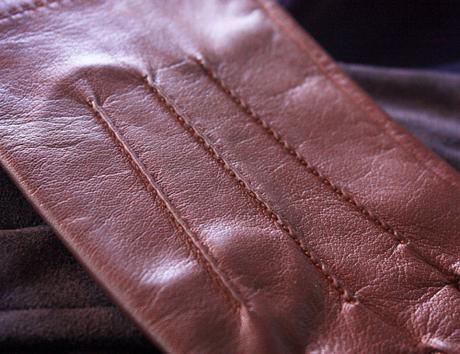
PROPER DRESS GLOVES
If you wear suits, you’ll probably want some proper dress gloves. Something made from a soft and fine leather – such as capeskin, hairsheep, or kidskin – will go well with tailoring. I like mine to have a bit of handsewing, particularly around the points (the three lines at the back), but am otherwise fine with machine-sewing.
Machine-sewing here makes sense, particularly around the fingers, since it allows the glovemaker to more easily turn the edges of the leather inward, such that they’re hidden from view. This gives the gloves a slimmer, more form-fitting appearance, which I find looks better with suits and sleek casualwear.
I also like find dress gloves do better when they’re unlined (or, at most, silk lined). Wool or cashmere linings lend warmth, but they also add bulk – turning what would have otherwise been an elegant pair of gloves into something that can look vaguely like an oven mitt. Sometimes you’re willing to put up with that bulk for some extra comfort on a cold day, but if so, my guess is that you’re also wearing an overcoat. At which point, I recommend wearing different gloves anyway.
Pictured below: Brown kidskin and gray suede kidskin gloves from Lavabre Cadet, the best maker I know for dress gloves. The company is known for the impeccably fine handsewing and use of soft kidskin leathers. I wear the brown pair above with suits, but the gray suede ones with all-black casualwear outfits (e.g. sleeker leather jackets with slim jeans and boots). You can find Lavabre Cadet at The Hanger Project (an advertiser on this site), Beige Habilleur, and Camille Fournet.
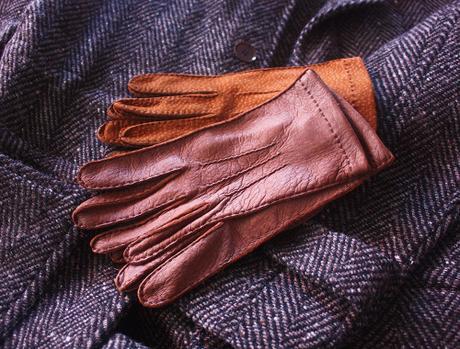
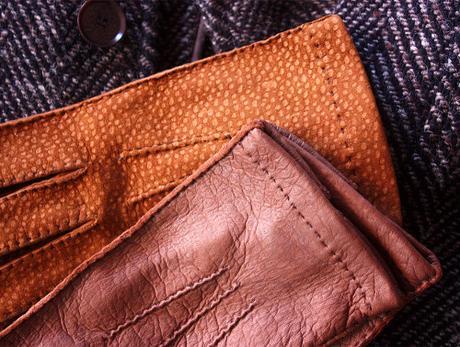
RUSTIC HANDSEWN GLOVES
Dress gloves look great with suits, but their silhouettes can seem dainty next to heavy overcoats and tweed sports jackets. For those occasions, I like handsewn gloves made from more interesting leathers.
You can get handsewn gloves made from almost anything, but I think they look particularly good in peccary and carpincho – sometimes referred to as the king and queen of glove leathers. The bottom pair you see above is made from peccary, which comes a kind of wild boar. It has a slightly grainy texture and unmatched soft feel. The top pair is carpincho (sometimes called capybera), which is taken from a South American water rodent. The leather is a little more spotted, which makes it look more distinctive from a distance.
You can tell these have been handsewn because the threads are thicker and stitching more irregular. Not all handsewn gloves look like this (see the Lavabre Cadet dress gloves above), but it’s hard to replicate this specific look with machines.
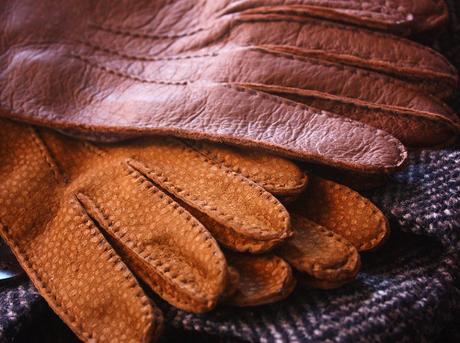
What separates these from dress gloves is really the fingers. Handsewn gloves often have out-turned edges, which means the edges of the leather face away from the hand. This completely changes the silhouette. Rather than the slim, elegant gloves mentioned in the previous section, these look bulkier and heavier. Their rugged sensibility allows them to sit well next to rustic materials, such as tweed, corduroy, and moleskin, as well as hefty, tailored outerwear.
Like my dress gloves above, however, I prefer these to be unlined. It’s a balancing act, really. When the edges are turned out, you’re already adding visual weight. Adding a cashmere lining just makes them heavier looking still. Perfectly fine if you live in a cold climate, but I prefer mine without. Plus, peccary is such a wonderfully soft leather. It would be a shame to own a pair and not be able to feel it against your skin.
Pictured above: Merola gloves in both peccary and carpincho. I find Merola to offer some of the best value in terms of top-end gloves. They’re not as expensive as Lavabre Cadet, but their quality is excellent. Also, easily had at places such as No Man Walks Alone, The Hanger Project, and Exquisite Trimmings (all three advertisers on this site), as well as Nitty Gritty, Beige Habilleur, and Trunk Clothiers.
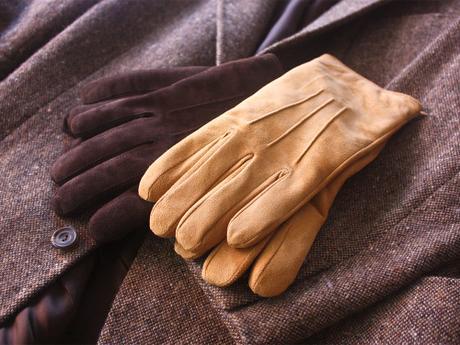
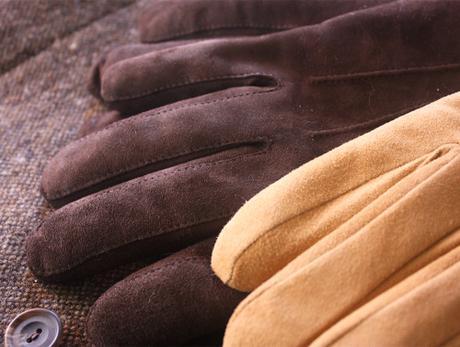
WOOL LINED GLOVES
If most of your gloves are unlined, like mine, then you’ll need at least a pair of lined gloves for truly cold days. Silk is nice, but adds little warmth. Instead, you’ll want to try some kind of wool. Lambswool and wool-blends are often the most robust, but they lack the softness and comfort of alpaca and cashmere.
I have two pairs of lined gloves – one pair in dark brown suede, the other in tan suede. Suede can be a nice way to add variety without venturing into louder colors (although, nothing wrong with louder colored gloves). The only downside is that they don’t age like smoother leathers. The nap can wear down, which is nice, but the leather doesn’t develop that deep, rich patina you see at the top of this post.
One interesting thing to note: the dark brown ones here are from Hestra; the tan suede ones from Merola. You can sometimes find Hestra gloves for cheap, but beware of the quality. Their top-end line is called their Table Cut Collection, which you can buy through Skoaktibolaget (an advertiser on this site). That collection looks wonderful, but Hestra also has lower-end gloves aimed at a broader audience. These, for example, are lined in lambswool instead of cashmere. The suede is also not nearly as supple as my Merolas; the three points on the back are a bit flat; and you can see the stitching along the fingers. Not the end of the world, but an explanation for why these only ran me about $125. Had I paid attention before buying them, I think I would have passed and gotten something from the Table Cut Collection instead.
Pictured above: Brown suede Hestra gloves lined in lambswool and tan suede Merola gloves lined in cashmere. You can find Hestra at Skoaktiebolaget, East Dane, Mr. Porter, J. Crew, and Uncle Otis.
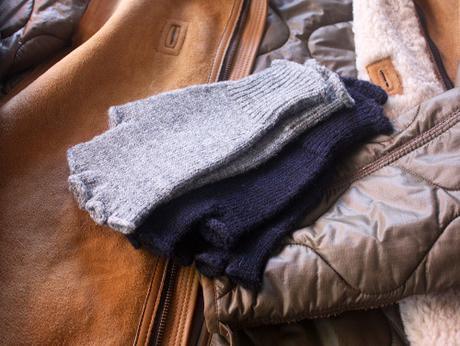
CASUAL KNIT GLOVES
Knit gloves get a bad rap – partly because many of us have bought the cheap, cotton-acrylic kind sold through drug stores and street vendors. You know the type. Thin and stretchy, they never really keep your hands warm before you eventually lose them in a cab or leave them behind at a bar (perhaps on purpose).
You can find good knit gloves, however, if you look. Getting a pair made from a thick, densely knitted wool actually isn’t the main problem. It’s getting a pair that fits around the palm of your hand (surprising for a knit). I tried a few pairs last year before eventually settling on these from Margaret Howell. They’re made in the UK from British wool, and the fingerless design allows me to easily operate smart devices. The company also has full-fingered ones, if you need.
Knit gloves don’t keep your hand as warm as leather ones, but they sometimes look better with casualwear. They’re also a lot cheaper, even if they come from designer lines.
Pictured above: Margaret Howell fingerless knit gloves in navy and gray.
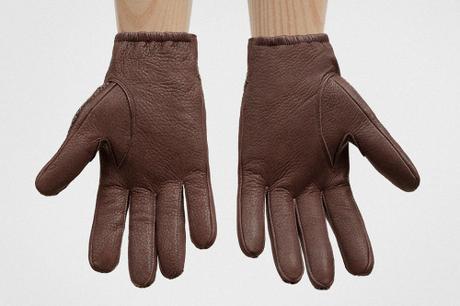
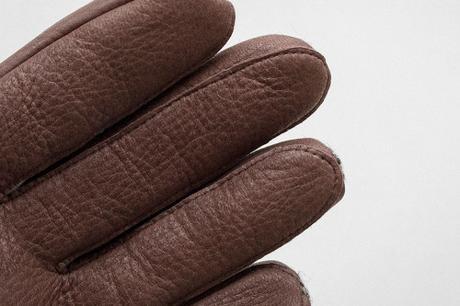
OUTDOORSY DEERSKIN GLOVES
For something that pairs well with workwear and outdoors-y clothing, try deerskin gloves. Deerskin has a lot of tensile strength, but still retains a good amount of elasticity. Its unique texture makes it pair well with casual, weekend outfits that rely on denim, canvas, and waxed cotton.
The ones above are from SEH Kelly, a brand I like, although I’ve been trying to get a pair from one of the many makers in Paris. Still trying to find the right brand, but once I do, I’ll do a post on Parisan glovemakers and shops. France is exceptional for leather goods, and is one of the main producers for top-end gloves (Lavabre Cadet is based in France).
For deerskin leather gloves, you may as well get them lined. They’ll look and feel better when you’re out and about in your peacoat or parka.
(picture above via SEH Kelly)
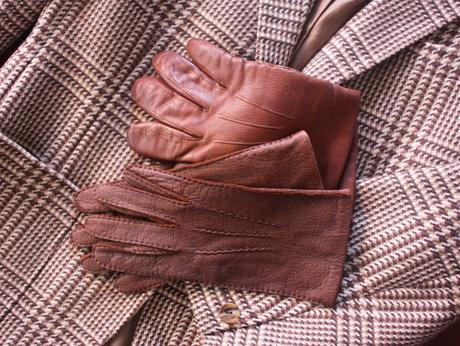
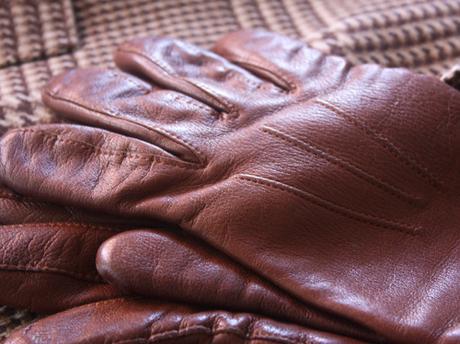
MORE AFFORDABLE ALTERNATIVES
A word about affordable options. Dents, a British maker, has a range of gloves that span the spectrum in terms of quality. No Man Walks Alone carries the better ones (more hand stitching, better linings), but you can also find cheaper varieties at Dent’s own site.
I also like Aarch for relatively affordable carpincho and peccary leather gloves. They’re a new upstart based in Australia, run by a young Vietnamese-Australian guy who has a passion for men’s style. The company’s gloves are all handcut and handsewn in Hungary. The quality of work is good, although the leathers are slightly less supple than similar pieces from Merola (the peccary ones you see above are from Aarch). Note that the site’s prices are listed in AUD. Customers paying in USD can expect about a 25% discount.
For a truly affordable buy, check shops such as Nordstrom, Ralph Lauren, Brooks Brothers, and Club Monaco. I bought a pair of Nordstrom gloves (pictured above) ten years ago and continue to be impressed with its value. There are obvious differences here in quality. Nordstrom’s gloves are full machine stitched, the edges on the fingers aren’t turned inwards, the points are a bit flat, and the leather has a bit of a sheen. Still, I think they’ve aged reasonably well for being ten years old (certainly better than I have in that same period). Not bad for the ~$50 I spent.
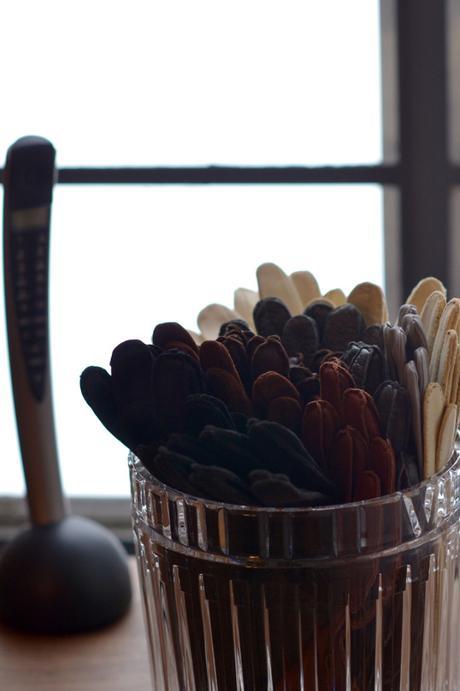
CREATIVE STORAGE
Finally, if you find yourself with too many gloves and don’t know how to store them, try sticking them in a crystal ice bucket. I took the idea from Voxsartoria, who uses something from Tiffany’s (I bought the same bucket because I lack imagination, but also because I needed something big enough to hold fifteen pairs of gloves). They run $165 at Tiffany’s, but can be had for about half the price on eBay. Just beware of fakes. Tiffany is one of the most counterfeited brands on the market.
For a smaller glove collection, check Ralph Lauren. They have more modestly sized ice buckets that I imagine could hold about ten pairs of gloves, depending on your leathers and linings. Again, you’ll be able to find cheaper versions on eBay.
Place the ice bucket near your doorway so you can always grab the right pair of gloves on your way out. The bucket can double as a champagne holder during parties.
(picture above via Voxsartoria)
